A career in engineering wasn’t always an ambition for Professor Justin Beland (MIE).
“For a good part of high school, I planned to become a firefighter, move to Thunder Bay to train, and return to Toronto, but I didn’t explore much outside of that,” says Beland, who joins the Department of Mechanical & Industrial Engineering as a new assistant professor, teaching stream.
“As I got closer to graduating, the principal at my high school suggested that I take physics, chemistry, calculus, biology and philosophy, instead of focusing solely on gym. I ended up developing a real interest in physics and calculus, and my motivation shifted toward academics with an interest in engineering.”
Following some sage advice from his mother, Beland began his engineering studies, which has followed a diverse path since his undergraduate days.
Graduating from Western University with a BESc in civil engineering and BSc in physics, he then made a pivot when entering his graduate studies at the University of Toronto to focus on optimization algorithms, probabilistic modelling and machine learning.
“After my undergraduate education, I wanted to leverage my background in structural engineering within aerospace by joining the advanced aerospace structures group at the University of Toronto Institute for Aerospace Studies (UTIAS),” says Beland.
He adds that his interest in aerospace was sparked after he attended air shows with his grandfather as a child, and later connected with the movie Apollo 13.
“But it turns out I couldn’t get into that program. Instead of seeing this as a setback, I ended up working with Professor Prasanth B. Nair (UTIAS), who focuses on algorithm development and creating new types of data-driven models, which turned out to align well with my career goals.”
During his graduate studies, Beland had the opportunity to work on research projects with far-reaching applications. These projects involved the development of novel function approximation algorithms and the extension of Bayesian optimization algorithms to high-dimensional problems and optimization under uncertainty. Applications of this work may involve the design of aircraft engines, biomedical systems, robot design, chemical/drug design, optimization of physics simulations and much more.
From this, Beland gained valuable insights from peers and collaborators. He was also involved in teaching curriculum and had the chance to instruct several machine learning courses for both undergraduate and graduate students.
Beland is now the newest instructor for MIE250: Fundamentals of Object-Oriented Programming and APS1070: Foundations of Data Analytics and Machine Learning. He also plans to introduce new courses based on his research as well as more in-depth courses related to deep learning methods.
“During my undergraduate and graduate studies, I learned programming, all sorts of mathematics, machine learning, engineering design and how to think like an engineer, all while meeting lifelong friends who I’m still in touch with, both professionally and personally,” he says.
“I want to apply those principles in my courses and make sure students are making the same kinds of connections to benefit them outside of the classroom. I’m excited to create a classroom environment that motivates and engages students, making the courses both fun and relatable.”
Along with a commitment to making complex topics understandable and accessible to students, Beland is also involved in work inside and outside of U of T Engineering. He continues to work on research projects stemming from his PhD research, including modelling techniques that link deep neural networks to Bayesian networks, Bayesian optimization methods for high-dimensional problems, and optimization under uncertainty.
“Where I am now is far different from where I imagined I would be when I was in high school,” he says.
“I’m looking forward to working with students to help them uncover their own goals and potential.”
Fifteen members of the U of T Engineering community are among the recipients of the 2024 Arbor Awards — the University of Toronto’s highest honour in recognition of exceptional and longstanding volunteer service.
“Volunteers are the foundation of our community, driving its success with their generosity and dedication. Their time and energy spark growth, build meaningful connections and open doors to new opportunities,” says Sonia De Buglio (ChemE 9T4, MASc 9T8), Director of Alumni Relations at U of T Engineering.
“These incredible alumni have dedicated their time to mentor students, assess university applications, host events to create community, sit on advisory boards and so much more.”
Established by U of T in 1989, the Arbor Awards are presented annually to alumni and friends whose loyalty, dedication and generosity have added substantially to the quality of the U of T experience.
Among the U of T Engineering recipients are Henry N. Cheung (EngSci 8T5) and Sarah W. Mak (IndE 8T6), who are founding members of the Engineering Alumni Association Hong Kong Chapter, and support alumni in the Hong Kong region through events, lectures and other outreach activities. Also recognized are alumni volunteers from the Iron Dragon team who coach students and promote personal growth through training and consultation.
“Simply put, our achievements wouldn’t be possible without them. They make a huge impact on the entire faculty, and it is an honour to celebrate them,” says De Buglio.
The 2024 U of T Engineering Arbor Award recipients are:
Marion E. Breukelman (GeoE 8T6)
Breukelman has played a key role in developing the Engineering Alumni Applicant Assessor program. Over the past eight years, she has continued to be a dedicated supporter, devoting countless hours to this alumni volunteer experience. Breukelman has also been instrumental in shaping the faculty’s admissions assessment process, providing her valuable insights on how this volunteer opportunity can be improved.
David N. Bowden (IndE 7T9)
Bowden is a long-standing champion of U of T who has served three terms on Governing Council as an Alumni Governor. His service on Council included membership on several boards and committees, including the Audit, Elections, Pension, and Planning and Budget committees. Bowden’s commitment to the wider community includes lending his expertise to the MaRS Discovery District.
Henry N. Cheung (EngSci 8T5)
Cheung is a steadfast champion of the Faculty of Applied Science & Engineering, and the U of T Hong Kong alumni community. He is a founding member of the Engineering Alumni Association Hong Kong Chapter, and served as its president for four years, beginning in 2018. Specific contributions include delivering an online talk during the pandemic and serving as moderator for the Fireside Chat Career Series, hosted by the engineering alumni chapter.
Jacqueline V. Csonka-Peeren (EngSci 8T8, MASc MIE 9T2)
Csonka-Peeren is a champion of Engineering Science who has volunteered many times to judge student competitions. She also led a fundraising campaign to establish the 8T8 Engineering Science Scholarship, in recognition of the 35th reunion of her graduating class. To date, more than $75,000 has been raised for the endowed award, which supports summer research opportunities for one or more students each year.
Ernesto Díaz Lozano Patiño (CivMin 1T5 + PEY, MASc 1T8)
A deeply engaged student who became Engineering Society President, Díaz Lozano Patiño continues to be heavily involved as an alum. He currently completed a four-year term on the College of Electors. His ongoing contributions to U of T Engineering include returning to speak to civil engineering students and rallying his fellow graduates from the class of 1T5 to fund a new scholarship.
Mehran Hydary (ElecE 1T5)
Hydary believes in actively giving back to the engineering community and to the Faculty of Applied Science & Engineering. He shared his leadership perspectives at the Skule Lunch & Learn, and BizSkule Speaker series where he discussed cryptocurrency. Most recently, he sat on the Engineering Alumni Network board, and chaired the Alumni Engagement subcommittee, which is building out a global ambassador program.
Iron Dragon Alumni Volunteers: Desmond H. Chan (CivMin 1T4), Hannah L. Fletcher (IndE 2T1), Michael Lucky (MechE 1T6), Yca T. Meriel (MSE 1T9), Courtney Siu (BA ‘19)
The Iron Dragon team is one of the top university dragon boat programs in the country, providing access to high-performance athletics for the U of T community. The team’s experienced coaches accommodate people new to the sport as well as those with years of experience, promoting personal growth through individual training and consultation.
Sarah W. Mak (IndE 8T6)
Mak is one of the founding members of the Engineering Alumni Association Hong Kong Chapter, which launched in 2014. She continues to take an active leadership role with the association by helping with the planning, promotion and execution of all chapter events, as well as with administration. Mak is also co-leading the planning and rollout of a quarterly Fireside Chat series.
Salvatore (Sam) Mantenuto (ElecE 8T0)
Mantenuto is a passionate supporter of the Faculty of Applied Science & Engineering. As a member of Faculty Council, he generously offers his time and advice, fostering strong connections within the community and industry. Meanwhile, as Chair of the Electrical & Computer Engineering Industry Advisory Board, Mantenuto provides strategic advice and actively makes introductions to new donors and industry partners.
Herman M. H. Ng (EngSci 0T5)
Ng is an enthusiastic, longtime supporter of the Faculty of Applied Science & Engineering. As an executive in data analytics, he has generously shared his expertise with students since 2007 as a mentor and guest speaker. His other roles include co-chair of a bootcamp on machine intelligence for fellow alumni, and serving as a career and recruitment ambassador for U of T Engineering and the Rotman School of Management.
Maithili Mavinkurve Thambinayagam (CompE 0T3)
Thambinayagam has inspired the next generation of engineering leaders as a committed volunteer at U of T Engineering. She has participated in various panels related to entrepreneurship, artificial intelligence and data, and has provided mentorship, advice and inspiration to female students in The Edward S. Rogers Sr. Department of Electrical & Computer Engineering. She also generously shared her thoughts as a Convocation Speaker in 2022.
See the full listing of the 2024 Arbor Award recipients.
The University of Toronto has signed a multi-year agreement with Siemens Canada that seeks to transform the energy grid and boost Canada’s ability to provide clean energy to communities.
The partnership will bring together U of T’s cutting-edge research, commercialization and policy expertise with Siemens’s industry-leading experience in sustainable energy management and intelligent infrastructure — all with a view to advancing Ontario’s energy transition goals and contributing to Canada’s target of achieving net-zero emissions by 2050.
“The University of Toronto is delighted to strengthen our relationship with Siemens by entering into this institutional partnership agreement,” says Leah Cowen, U of T’s vice-president, research and innovation, and strategic initiatives, at a signing ceremony held Nov. 21 at Hart House.
“This framework agreement will generate broad and deep mutual value enabling both Siemens and U of T to build a green future together as global organizations with global ambitions.”
The partnership expands on U of T’s existing ties with Siemens: the company is partner in U of T’s Grid Modernization Centre, which brings together companies and U of T researchers to advance decarbonization of the electric grid while supporting innovation in clean energy technologies, policy advocacy and financing. The centre is led by Climate Positive Energy, a U of T institutional strategic initiative that leverages research expertise across the university to support efforts to curb carbon emissions, reimagine energy systems and facilitate an equitable transition to a clean energy future in Canada and globally.
“We are thrilled to strengthen our partnership with the University of Toronto through signing this framework agreement,” says Faisal Kazi, president and CEO of Siemens Canada.
“Today marks not just another step but the continuation of a collaborative journey we’ve nurtured over many years. I look forward to seeing continued leadership and innovation as a result of this agreement.”
The partnership with Siemens Canada is part of ongoing efforts across the university to address grid modernization and accelerate the transition to a more sustainable future powered by clean energy.
For example, researchers on all three campuses are currently contributing to efforts to transform Canada’s energy grid — and the infrastructure that powers homes, buildings and electric vehicles — into an intelligent and secure grid. The resulting “smart grid” will leverage the latest advances in AI to appropriately direct energy to the points of highest need at critical times to avoid power outages.
The undertaking combines two areas where U of T is among the world leaders — sustainability and AI. U of T was named the most sustainable university in the world in the 2024 QS World University Rankings, and is a longstanding leader in AI research, thanks in part to the efforts of luminaries like University Professor Emeritus Geoffrey Hinton, whose foundational discoveries and inventions were recently recognized with a Nobel Prize.
At the same time, U of T researchers are also at the forefront of addressing emerging challenges associated with the transition to a smart grid. That includes security considerations — which will be among the key areas of focus for U of T’s partnership with Siemens, a leading supplier of electrical components to utilities.
For example, Professor Deepa Kundur, chair of the Edward S. Rogers Sr. department of electrical and computer engineering in the Faculty of Applied Science & Engineering, leads a research group that’s exploring exploring how to defend power utilities from cyberattacks.
Working with industrial partners across different sectors, these and other U of T researchers are helping companies make better use of resources and enabling safe access to emerging green technologies.
Going forward, U of T’s collaboration with Siemens will expand beyond energy systems to encompass other crucial sectors such as AI, automation and advanced manufacturing.
New funding from the Ontario Research Fund (ORF) will advance twelve projects from across U of T Engineering, with applications ranging from sustainable aviation to next-generation electric vehicle battery systems.
Two of the projects are based at U of T Engineering’s Thermal Management Systems (TMS) Laboratory and focus on improving the way battery systems handle heat, as well as developing lightweight structural battery pack components.
“Whether they are being used for electric vehicles or for stationary energy storage systems that reduce strain on the grid, lithium-ion batteries are transforming the way we use electricity,” says Carlos Da Silva, Senior Research Associate at the TMS Lab and Executive Director of U of T’s Electrification Hub.
“Unfortunately, today’s batteries are still sensitive to temperature: if they get too cold or too hot, it can degrade their performance and even present safety risks. We are working on new technologies that make batteries more resilient to thermal fluctuations.”
Led by Professor Cristina Amon (MIE), researchers from the TMS lab are building advanced computational modelling and digital twin methodologies that predict and optimize how heat flows through battery packs. The methodologies are carefully calibrated and validated through industry-relevant experiments in the lab.
These methodologies will help battery designers anticipate and prevent thermal management challenges before they arise. It can also enable them to optimize the design and deployment of fire mitigation measures, such as ultra-thin heat barriers, within their battery systems.
The team is also collaborating with Ford Canada and several other companies in the energy storage space. For example, they have worked with Jule (powered by eCAMION) on the development of direct current electric vehicle fast chargers with integrated battery energy storage systems, one of which was recently unveiled on the U of T campus.
“We are grateful for this ORF-RE funding, which will accelerate our research and help us further expand our partnerships, ensuring that battery thermal innovations have a seamless transition from the lab to the marketplace,” says Amon.
“As a result of this work, the next generation of batteries will be safer and more resilient than ever before, which is especially important in colder climates like ours here in Ontario.”
The full list of U of T Engineering principal investigators and their associated projects funded by ORF-Research Excellence and ORF-Small Infrastructure Fund in the latest announcement is:
- Cristina Amon (MIE) — Next-Gen Electric Vehicle Battery Systems: Lightweight, Thermally Performant and Fire Safe for all Climates
- Cristina Amon (MIE) — Powering Ontario’s Grid Transformation and Electric Vehicle Fast Charging with Thermally Resilient Battery Energy Storage
- Aimy Bazylak (MIE) — RECYCLEAN: Critical Minerals Recycling & Re-manufacturing for the Energy Transition
- Ali Dolatabai (MIE) — Advanced cold spray facility
- Clinton Groth (UTIAS) — Hydrogen as a Sustainable Aviation Fuel – Combustion Research to Remove Impediments to Adoption in Gas Turbine Engines
- Xilin Liu (ECE) — Integrated circuits for wireless brain implants with multi-modal neural interfaces
- Caitlin Maikawa (BME) — Biointerfacing materials for drug delivery lab
- Emma Master (ChemE) — Accelerating biomanufacturing innovation through enhanced capacity for scale-up and downstream bioprocess engineering
- Seyed Mohamad Moosavi (ChemE) — Machine learning for nanoporous materials design
- Enid Montague (MIE) — Automation and equity in healthcare laboratory
- Javad Mostaghimi (MIE) — A New Generation of Compact, Transportable Mass Spectrometers for Rapid, In-Field Sample Analysis
- Shurui Zhou (ECE) — Improving collaboration efficiency for fork-based software development
On November 21, more than 200 guests gathered at U of T’s Schwartz Reisman Innovation Campus to celebrate and explore mutually beneficial partnerships between academia, industry and community organizations.
The event, held for the first time since 2019, was co-hosted by the U of T Engineering partnerships office and the University-wide Blue Door partnerships office, as well as by Toronto Global. Presenters included Arzhang Seddighi of Marvell Technology Inc., and Faisal Kazi, CEO of Siemens Canada, who gave the keynote address.
“I hardly need to point out how much the world has changed over the past five years,” said Christopher Yip, Dean of U of T Engineering at the event.
“What hasn’t changed is the need for the kinds of solutions that come from research, innovation and collaboration. Tonight, for the first time, we can proudly say we are welcoming all of our industry partners together at one time to celebrate the partnerships we’ve formed and imagine the partnerships yet to come.”
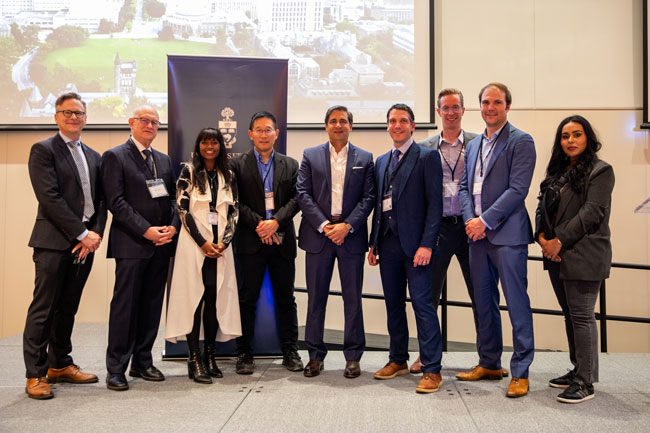
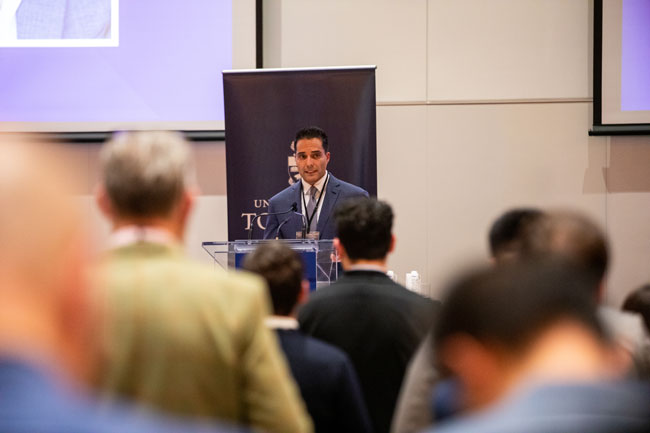
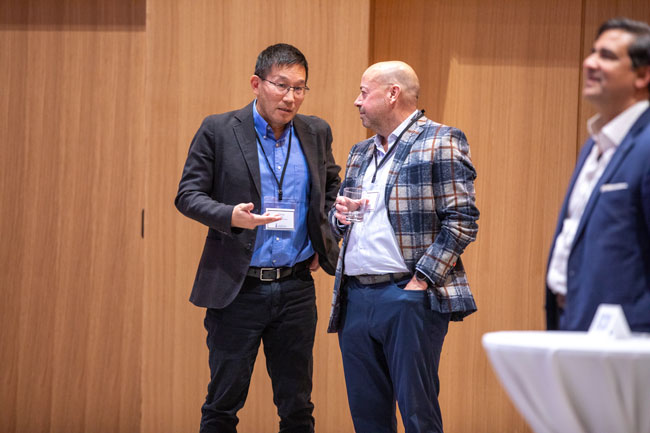
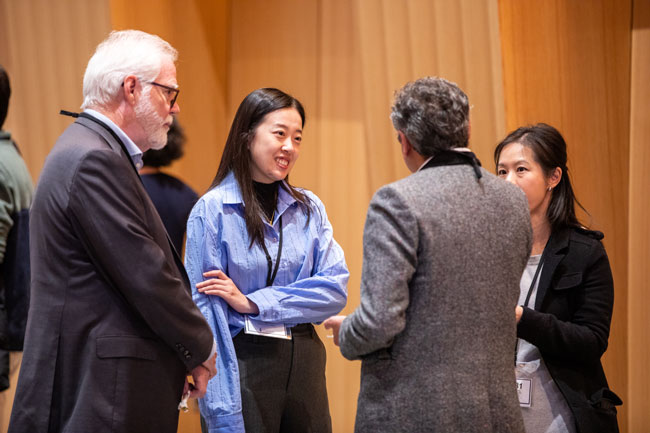
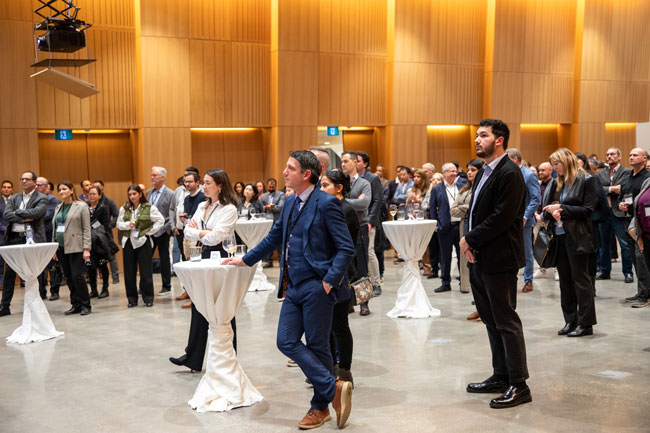
View more photos from the event on our Flickr gallery
A U of T Engineering student team working on synthetic biology research and innovation has achieved its best results to date at the International Genetically Engineered Machine (iGEM) competition, with a platform to counter so-called superbugs that resist antibiotic treatment.
The annual event, held in Paris, France from October 23–26, is the world’s largest synthetic biology competition, attracting over 5,000 attendees.
The iGEM Toronto team competed against more than 400 teams from 48 countries and placed in the top 10 of the overgraduate category — which comprises of teams with at least one graduate student. They also received awards for the best model and best entrepreneurship.
“Our grand goal as a team is to generate new DNA sequences and create entirely new genomes using machine learning models,” says Jaden Bhogal (Year 3 EngSci), who is co-president of iGEM Toronto along with Amogh Manivannan (Year 3 ChemE).
“But we’re starting with the simplest proof of concept, which is making new plasmid sequences, which are small, circular pieces of DNA that are found in bacteria and other organisms.”
With the support of their academic advisor Professor Christopher Lawson (ChemE), who is also core principal investigator at U of T’s BioZone, as well as Professors Michael Garton and Freeman Lan (both BME), the team started working with plasmids from E. coli bacteria to see if they could generate new sequences and validate their functionality, both computationally and in the wet lab.
“Plasmids are a fascinating but much under-studied form of life in the microbial world. They aren’t alive, but like viruses, they take on a life of their own. They have tremendous impact on microbial ecology, evolution and biotechnology,” says Lan.
“In some ways, they are the simplest form of life and so it is a natural starting point to generate life by artificial intelligence.”
“Our aim is to leverage the existing data that we have about different organisms and plasmid sequences, and be able to teach a machine learning model to understand what a plasmid sequence is, and generate novel sequences,” says Adibvafa Fallahpour, a third-year student studying computer science and neuroscience, who is part of the dry lab sub-team.
“Down the road, once the model is able to generate sequences, we would then condition it to develop sequences that might be antibacterial or have different medically beneficial properties.”
When the team was looking for a problem to tackle with their platform, which is called Plasmid.AI, they chose antibiotic resistance — a top global public health concern.
“Our human practices sub-team, which looks at the impact our technology could have on different communities and what to consider there, examined many different possible applications of our project,” says Bhogal.
“We chose antibiotic resistance because of its staggering death toll and because it’s a challenging and costly problem to solve.”
The solution that the team is developing to counter these superbugs that can withstand antibiotic treatment involves creating AI-generated plasmids that can impede the genetic resistance mechanisms inside the bacteria.
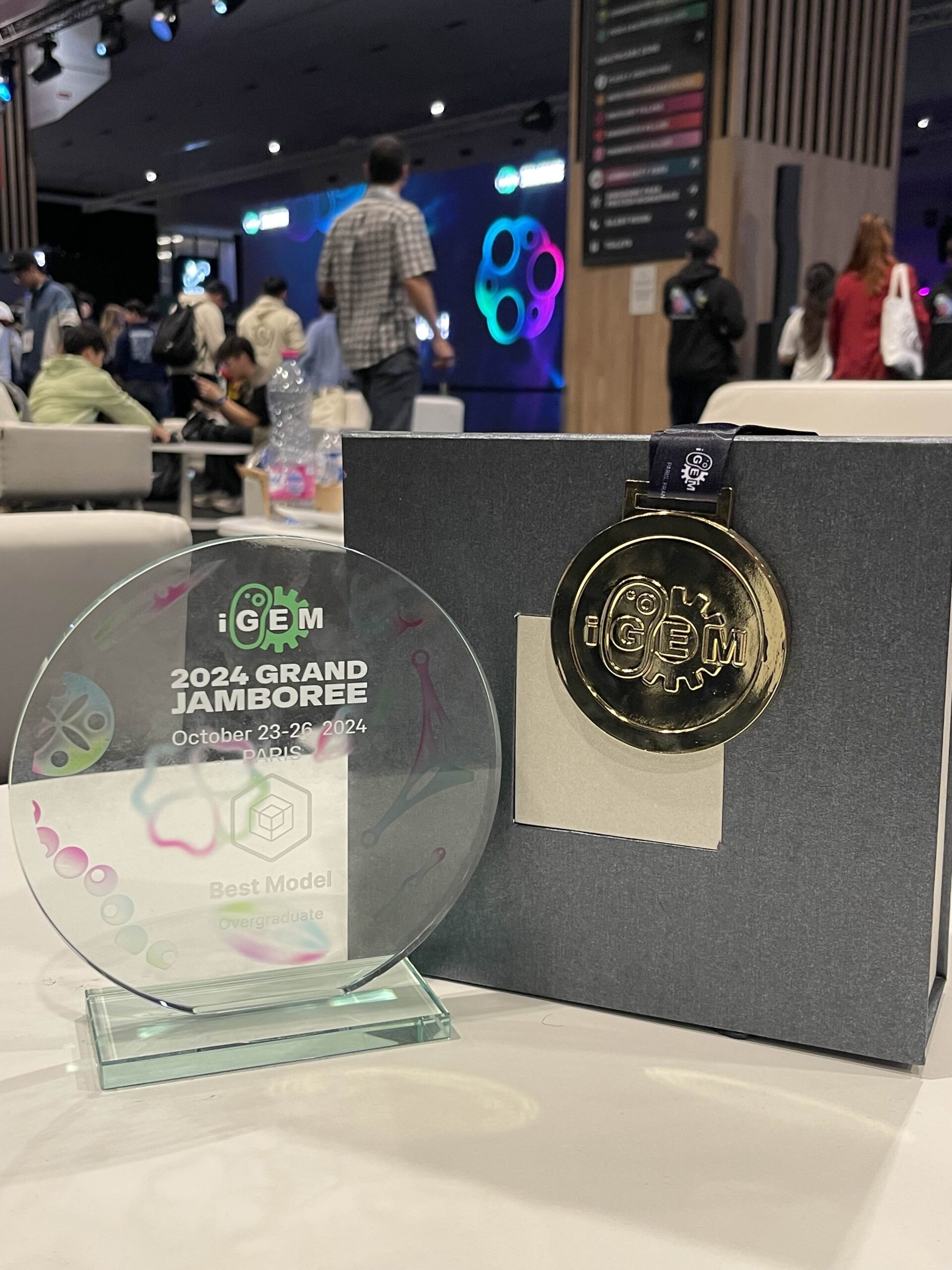
The team had to consider challenges from multiple perspectives, including working with large data sets of plasmid sequences to train the Plasmid.AI model. They also had to ensure they were putting guard rails around the model to filter out and prevent the output of harmful sequences.
The human practices sub-team, led by Esha Mohan, a fourth-year student studying environmental science and ecology & evolutionary biology, was tasked with designing a framework to address the safety and regulatory considerations of the project.
“The idea of being able to make any new DNA sequence with any new functionality, despite it being very far down the road, is something that would require a lot of regulation and detailed frameworks,” says Bhogal.
While the iGEM Toronto team has been competing since 2007, this past year was one of its teams largest to date with 60 members. It was also the first year iGEM Toronto had a formal entrepreneurship team.
This sub-team, led by Santiago Plata Salazar, a fourth-year student studying fundamental genetics and cellular & molecular biology, was one of the only iGEM teams to participate in the BioInnovation Fair at iGEM’s Grand Jamboree in Paris — an event featuring startups, incubators, venture capitalist and industry leaders.
The startup also competed in The U of T Entrepreneurship Hatchery’s Demo Week 2024 this fall and is now continuing its work towards commercialization in the Go To Market stage.
“I think one of the reasons for our success this year was our cohesion and strong team dynamics,” says Fallahpour. “Having a shared vision and strong communication ensured that all the sub-teams were able to build on top of each other’s work.”
“It was a monumental effort from everyone and to see the raw passion and talent coming from each team member was truly incredible,” adds Bhogal. “I am truly grateful for the support of my fellow co-president, Amogh, and to all of the dedicated sub-team leads, team members, advisors, faculty and sponsors that made this project a success.”
The team plans to continue to explore this work with the support of their academic advisors.
“Next steps include improving the model, fully characterizing the generated plasmids and comparing them with natural plasmids,” says Lan. “Eventually, we hope to focus the model to generate plasmids with qualities that are useful in biotechnology.”
